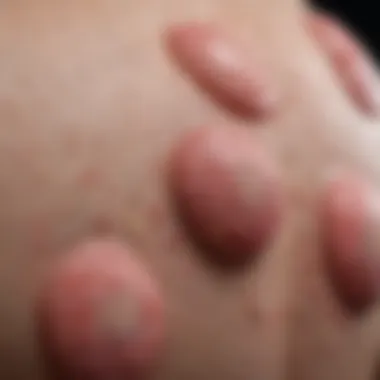Understanding Dyshidrotic Eczema: Is It Serious?


Intro
Dyshidrotic eczema is a dermatological condition that warrants attention due to its sudden onset and unpleasant symptoms. Characterized by small, itchy blisters on the hands and feet, this skin disorder can disrupt daily life for those affected. While it may not pose immediate life-threatening risks, the recurrent nature of dyshidrotic eczema raises essential questions about its seriousness and implications for patients. Understanding this ailment involves delving into its definition, common symptoms, triggers, and treatment approaches.
Key Concepts
Definition of Primary Terms
Dyshidrotic eczema, often referred to as pompholyx, manifests through blistering on the surfaces of the hands and feet. The blisters can be intensely itchy and may lead to discomfort and frustration, impacting the quality of life. This condition falls under the broader category of eczema, which includes various inflammatory skin diseases characterized by red, itchy skin and rashes.
Related Concepts and Theories
The understanding of dyshidrotic eczema is enriched by exploring the following concepts:
- Atopic dermatitis: Another common form of eczema that can sometimes coexist with dyshidrotic eczema.
- Contact dermatitis: This refers to skin irritation from allergens or irritants, which may trigger dyshidrotic flare-ups.
- Triggers: Common aggravators include stress, humidity, and exposure to certain metals like nickel and cobalt.
These related concepts can explain why some individuals are more predisposed to experiencing this condition than others.
Future Directions
Gaps Identified in Current Research
Despite existing studies on dyshidrotic eczema, several gaps remain. For instance, little is known about the precise genetic factors that could contribute to its development. Research often focuses on symptomatic relief rather than understanding the root causes or preventive strategies for future occurrences.
Suggestions for Further Studies
- Longitudinal studies: These could provide insights into how dyshidrotic eczema progresses over time among different individuals.
- Behavioral assessments: Analyzing how lifestyle choices affect flare-ups could offer new management approaches.
- Genetic research: Investigating the heritability of dyshidrotic eczema might reveal underlying predispositions.
Enhanced understanding of these aspects may ultimately lead to improved treatment and management strategies for those suffering from this condition.
Preface to Dyshidrotic Eczema
Dyshidrotic eczema is a condition that deserves attention due to its impact on those affected. This article aims to provide a comprehensive understanding of what dyshidrotic eczema is, its causes, symptoms, and treatments available. By examining the facets of this skin disorder, readers can better appreciate its serious nature and the implications it has on daily life.
Focusing on the nature of dyshidrotic eczema is essential for several reasons. First, it is vital for people who experience this condition to recognize it early. Understanding its symptoms can lead to prompt management and treatment, reducing potential suffering. Furthermore, this knowledge assists individuals in identifying their triggers and improving their quality of life.
In addition, awareness and comprehension allow patients and caregivers alike to engage in informed discussions with healthcare professionals. This awareness reflects on the emotional and psychological well-being of individuals, which is often overlooked. Now let’s explore the definition and the general context surrounding dyshidrotic eczema in greater detail.
Definition and Overview
Dyshidrotic eczema, also known as pompholyx, manifests as small, itchy blisters on the palms of the hands and the soles of the feet. These blisters are typically filled with fluid and cause significant discomfort. The condition can cause the skin to become cracked and peeling, leading to a further cycle of irritation.
The exact cause of dyshidrotic eczema remains somewhat elusive. However, it is believed to be related to a combination of genetic and environmental factors. The flare-ups may occur suddenly and can be recurring, affecting the quality of life for the sufferers. It is essential to note that while the symptoms can be distressing, dyshidrotic eczema is not contagious or life-threatening.
Prevalence and Demographics
Dyshidrotic eczema is relatively common, particularly among adults aged 20-40 years. Statistics indicate that this condition accounts for a significant proportion of eczema cases. Individuals with a family history of eczema or related skin conditions are at a higher risk of developing dyshidrotic eczema. Furthermore, certain professions that require frequent hand washing or exposure to irritants may see a higher prevalence.
The demographics of affected individuals also vary. Both men and women can develop this condition, although research shows that women seem to be slightly more affected than men. Stress, seasonal changes, and temperature fluctuations can influence the condition's appearance, making understanding these factors crucial for management.
"Recognizing and addressing dyshidrotic eczema can lead to improved management and a better quality of life for individuals."
In summary, having a clear understanding of dyshidrotic eczema is fundamental. From its definition and overview to the demographics of those affected, the first steps in addressing this condition lie in awareness and education.
Causes of Dyshidrotic Eczema
Understanding the causes of dyshidrotic eczema is crucial. Identifying these factors can help patients manage their condition more effectively. Knowing the underlying reasons for flare-ups leads to better prevention techniques and informs treatment strategies. This section explores three primary causes: genetic factors, environmental triggers, and allergic reactions.
Genetic Factors
Genetic predisposition plays a significant role in dyshidrotic eczema. Those with a family history of eczema or other allergic conditions are more likely to develop this specific type. Research shows that certain genes are associated with skin barrier function. When these genes are compromised, the skin becomes more susceptible to irritants and allergens.
Families often share environmental factors alongside genetic predispositions. This can create a compounding effect, influencing the likelihood of dyshidrotic eczema developing in multiple family members. Genetic understanding allows researchers to develop targeted treatments. Those aware of their familial risks can adopt proactive measures.
Environmental Triggers
Environmental factors significantly influence dyshidrotic eczema. Common triggers might include:
- High humidity or excessive sweating: These conditions can increase the chances of blister formation.
- Exposure to irritants: Chemicals or harsh soaps can compromise the skin barrier, leading to flare-ups.
- Stress: Emotional stress can manifest physically, worsening the eczema condition.
- Seasonal changes: Some individuals find their symptoms fluctuate with the changing seasons, particularly in winter when the air is drier.


By understanding these triggers, individuals can make adjustments to their daily lives. For instance, wearing breathable materials can help during high humidity, while using gentle soaps can minimize the chance of irritation.
Allergic Reactions
Allergic reactions are another important cause of dyshidrotic eczema. Many individuals have specific sensitivities that can trigger flare-ups. Common allergies include:
- Nickel: Found in many everyday items, skin contact can provoke an immune response.
- Fragrances: Products with strong scents often contain allergens that irritate sensitive skin.
- Latex: Those with a latex allergy may experience a reaction on areas of contact.
Identifying and avoiding allergens forms a key part of managing dyshidrotic eczema. Tracking symptoms and consulting with an allergist can provide valuable insights into personal sensitivities. Taking preventive steps, like using allergy-free products, can significantly reduce the occurrence of symptoms.
Understanding the causes of dyshidrotic eczema allows individuals to navigate their condition more effectively. With this knowledge, management strategies can be tailored to each person's unique triggers and symptoms.
Symptoms of Dyshidrotic Eczema
Understanding the symptoms of dyshidrotic eczema is crucial for anyone impacted or interested in this condition. Recognizing these signs can aid in timely interventions and effective management. Symptoms typically manifest as physical changes, persistent itchiness, and can extend their effects to influence daily life.
Physical Manifestations
The physical manifestation of dyshidrotic eczema presents as distinct symptoms that often emerge suddenly. Characterized by small, raised blisters, these lesions usually occur on the palms of the hands and the soles of the feet. They are often grouped together and can be filled with fluid, causing noticeable swelling. Over time, these blisters may dry out and result in the skin cracking, leading to potential discomfort and an unsightly appearance.
Individuals may also experience thickened skin in chronic cases, which can alter the texture and function of the affected areas. Such visual elements require careful observation, especially as changes can indicate progression or severity of the condition. Being alert to these signs is pivotal for early identification and treatment.
Itchiness and Discomfort
One of the hallmark symptoms of dyshidrotic eczema is intense itchiness. The urge to scratch can be overwhelming and often exacerbates the condition, leading to secondary issues such as skin infections. This incessant itching can disturb concentration and lead to insomnia for some individuals.
The discomfort associated with this eczema isn't solely physical. The cycle of itching followed by scratching can sometimes lead to painful fissures in the skin, further contributing to the discomfort. Finding relief becomes a priority for affected individuals, underscoring the need for effective treatment strategies.
Impact on Daily Life
Dyshidrotic eczema does not just present symptoms; it has broader implications on daily living. The visible nature of the condition can provoke feelings of self-consciousness in social situations, impacting personal interactions and quality of life.
In professional contexts, those with dyshidrotic eczema may encounter challenges in performance and collaboration due to discomfort or visible symptoms that may distract or deter colleagues. Activities as routine as typing, shaking hands, or even walking can become complex when dealing with symptoms.
Moreover, emotional and psychological impacts should not be ignored. Individuals may experience anxiety or frustration that arises from the management of their symptoms and appearance.
"Understanding the symptoms provides a foundation to cope with the challenges presented by dyshidrotic eczema."
Recognizing how symptoms affect one's life can inform treatment decisions and improve coping strategies. Knowledge about symptoms can empower individuals to engage more fully in their lives, offering a pathway to both physical relief and emotional resilience.
Is Dyshidrotic Eczema Serious?
Understanding the seriousness of dyshidrotic eczema is critical for those experiencing its symptoms. This condition not only affects physical health but can also impact emotional well-being and daily life. Recognizing the potential implications helps patients and healthcare providers develop effective management plans. It is essential to consider how symptoms can vary significantly between individuals and how these variations can determine the seriousness of the condition.
Severity of Symptoms
The severity of symptoms in dyshidrotic eczema is a primary concern. Individuals may experience a range of manifestations, from mild irritation to debilitating discomfort. The blisters associated with this condition often appear suddenly and can be intensely itchy. For some, these blisters can lead to skin cracking and scaling, which may exacerbate the itching.
Here are common symptoms that can indicate severity:
- Intense itching: The urge to scratch can lead to further skin damage.
- Large blisters: Larger or more painful blisters can indicate a more severe flare.
- Inflammation: Redness and swelling around the affected areas may suggest an intensified reaction.
While many individuals manage their symptoms at home, severe cases require medical attention. Treatment options may include stronger topical medications or other interventions.
Risk of Secondary Infections
Dyshidrotic eczema presents a risk of secondary infections, primarily when the skin barrier is compromised. Scratching and blistering can break the skin, leaving it vulnerable to bacterial or fungal infections. Common symptoms of secondary infections include:
- Increased redness: An expanding area of redness around the initial lesions can signal infection.
- Pus or discharge: The presence of fluid from the blisters could indicate a bacterial infection.
- Fever: In more severe cases, systemic symptoms like fever may occur.
It is crucial for patients to remain vigilant about their skin condition and seek medical intervention if signs of infection arise. Proactive care can help prevent complications and long-lasting effects on skin health.
Long-term Health Implications
The long-term implications of dyshidrotic eczema are another area of concern for patients. Persistent flare-ups can lead to chronic skin changes, such as thickening or hyperpigmentation. Some individuals may also develop a unified pattern of skin changes called lichenification, which alters the skin's texture and function.
This condition can also interfere with daily activities and mental health. Individuals may experience isolation due to embarrassment over visible lesions or the chronic discomfort associated with their symptoms.
It is advisable for individuals living with dyshidrotic eczema to consider regular follow-ups with healthcare providers. Early intervention for flare-ups and ongoing education about management strategies can significantly enhance quality of life.


Treatment Options for Dyshidrotic Eczema
Effective management of dyshidrotic eczema is crucial for individuals affected by this condition. This section will explore various treatment options available, detailing their benefits, applications, and considerations. These treatments are not only essential for alleviating symptoms but also prevent future flare-ups and improve quality of life. Understanding the nuances of each option can empower patients and caregivers in managing dyshidrotic eczema more effectively.
Topical Corticosteroids
Topical corticosteroids are often a first-line treatment for dyshidrotic eczema. These anti-inflammatory medications work by reducing inflammation and suppressing the immune response in the affected areas. Different formulations are available, ranging from mild to potent. The choice of potency depends on the severity of the condition and the specific areas involved.
Benefits:
- Rapid reduction of itching and redness.
- Can be applied directly to the lesions.
- Generally considered safe for short-term use.
Considerations:
- Long-term use may lead to skin thinning or other side effects.
- It is important to follow a dermatologist's instructions regarding frequency and duration of application.
Moisturizers and Emollients
Regular use of moisturizers and emollients is another key part of treating dyshidrotic eczema. These products help to hydrate the skin and restore its natural barrier. Maintaining skin moisture can lessen the occurrence of flare-ups and provide comfort during existing episodes.
Benefits:
- Helps to alleviate dryness and scaling.
- Provides a protective barrier against irritants.
- Can be used alongside other treatments for synergistic effects.
Considerations:
- Choose fragrance-free options to minimize potential irritation.
- Periodic reapplication is necessary, especially after handwashing or exposure to water.
Phototherapy
Phototherapy uses controlled exposure to ultraviolet light to treat dyshidrotic eczema. This technique may be beneficial for individuals with moderate to severe symptoms who do not respond well to topical treatments.
Benefits:
- Can significantly reduce the frequency and severity of flare-ups.
- Promotes skin healing and reduces inflammation.
Considerations:
- Requires multiple sessions, usually scheduled in a clinical setting.
- Sensitive skin may experience side effects, such as sunburn-like symptoms.
- Continuous monitoring is necessary to ensure safe exposure levels.
Oral Medications
In some cases, dermatologists may prescribe oral medications for managing dyshidrotic eczema, particularly if the condition is widespread or severe. These can include corticosteroids, immunosuppressants, or other systemic treatments.
Benefits:
- Provides relief for extensive eczema that does not respond to topical treatments.
- May improve overall skin condition and reduce systemic symptoms.
Considerations:
- Oral medications can have significant side effects, requiring careful monitoring.
- They are typically used for short periods or for severe cases only.
Effective management of dyshidrotic eczema requires a multifaceted approach.
Balancing topical treatments with moisturizers and possibly incorporating phototherapy or oral medications can lead to better outcomes.
Consultation with a healthcare professional is essential for personalizing treatment regimens and ensuring safety.
By understanding these treatment options, individuals living with dyshidrotic eczema can take proactive steps toward effective management of their condition.
Prevention Strategies
Dyshidrotic eczema can significantly affect a person's quality of life. Therefore, prevention strategies play a key role in managing the condition. By identifying triggers and implementing effective skincare routines and lifestyle modifications, individuals can mitigate flare-ups and improve their overall well-being.
Identifying Triggers
Understanding triggers is crucial for anyone who suffers from dyshidrotic eczema. Triggers may vary from person to person but commonly include:
- Environmental factors: Excessive heat, humidity, and prolonged exposure to water can exacerbate symptoms.
- Substances contact: Irritants like soaps, detergents, and chemicals present in various products can lead to outbreaks.
- Dietary influences: Some foods, particularly those containing allergens, could be significant sources of irritation.
To identify personal triggers, keep a detailed diary noting when outbreaks occur and any potential factors that preceded them. This proactive approach allows individuals to pinpoint problematic areas and adjust accordingly.
Skincare Routines


A consistent and tailored skincare routine is essential in managing dyshidrotic eczema. Here are several key components of a good routine:
- Regular moisturizing: Use high-quality moisturizers, particularly those formulated for sensitive skin. Applying emollients immediately after bathing helps lock moisture in.
- Gentle cleansing: Choose mild, fragrance-free cleansers to reduce irritation. Avoid long, hot showers as they may strip natural oils from the skin.
- Use of protective barriers: Consider using gloves while washing dishes or handling irritants to safeguard the skin.
Creating a ritual around skincare can reinforce habits and make them more effective, ultimately reducing the frequency of flare-ups.
Lifestyle Modifications
Lifestyle choices also influence the management of dyshidrotic eczema. Here are some changes that may promote better skin health:
- Stress Management: High stress can be a significant trigger for eczema flare-ups. Techniques like mindfulness, yoga, or other forms of relaxation can help.
- Balanced Diet: A diet rich in fruits, vegetables, and healthy fats can fortify skin health. Hydration is equally crucial; aim for adequate water intake daily.
- Avoiding known allergens: Reducing exposure to known allergens can help minimize symptoms. Consider allergy testing if unsure.
With focused preventive strategies in place, individuals can take charge of their dyshidrotic eczema management. These measures collectively contribute to a more comfortable life.
When to Seek Medical Advice
When managing dyshidrotic eczema, knowing when to seek medical advice is critical. This condition can vary significantly in its severity and impact on daily life. Early consultation with a healthcare professional can be beneficial in preventing complications and improving management strategies.
Signs of Complications
Recognizing the signs of complications is essential. Here are key indicators:
- Increased Severity of Symptoms: If the blisters become more inflamed or widespread, it may signify a need for medical intervention.
- Signs of Infection: Watch for symptoms such as redness, swelling, or pus around the affected areas. Fever and chills can also indicate an infection.
- Persistent Itchiness or Pain: If the discomfort interferes with daily activities or sleep, professional help is advisable.
- Failure to Respond to Treatment: If prescribed treatments do not alleviate symptoms over time, it is crucial to revisit the doctor.
Consulting a dermatologist can help in identifying these complications and customizing a treatment plan.
Consultation with Dermatologists
Consultation with a dermatologist is vital if you suspect complications or if self-care measures do not yield results. Dermatologists are specialists in skin conditions and can provide tailored advice based on individual circumstances. Factors to consider during a consultation include:
- Comprehensive Evaluation: A dermatologist can perform tests to better understand the severity and type of eczema.
- Customized Treatment Plans: They can recommend specific treatments that may not be available over the counter.
- Management of Side Effects: Specialized care ensures that any side effects from treatments are monitored and managed effectively.
- Long-term Monitoring: Regular check-ups can help track the condition over time and adjust treatments as necessary.
In summary, understanding when to seek medical advice regarding dyshidrotic eczema is paramount. Paying attention to symptoms and recognizing when complications arise can significantly enhance the quality of life for those affected.
Living with Dyshidrotic Eczema
Living with dyshidrotic eczema can significantly affect daily life. This condition is not solely a physical challenge; it can have emotional and psychological implications as well. Understanding these effects is crucial, as it helps individuals cope and manage their condition better.
The unpredictability of flare-ups can lead to heightened anxiety. This is particularly true during social situations or when engaging in activities that could aggravate symptoms. Individuals may experience fear of judgment or embarrassment, especially because the blisters can sometimes be quite visible. Hence, the mental health aspect of living with dyshidrotic eczema warrants attention and care.
Emotional and Psychological Effects
Dyshidrotic eczema is often accompanied by a range of emotional responses. Frustration and helplessness can arise, especially when symptoms disrupt everyday activities. Some people report feeling isolated due to the hidden nature of their discomfort. Others may struggle with self-esteem, as the visible symptoms can alter their perception of body image.
Studies suggest that those affected by skin conditions are more prone to anxiety and depression. This may be because they face challenges that are not easily understood by others. Coping with the symptoms physically can take a toll on mental wellbeing.
To nurture mental health, it is essential to engage in activities that promote relaxation and stress reduction. These can include meditation, yoga, or simply pursuing hobbies that foster joy. Therapy may also provide a supportive outlet for discussing feelings about the condition. Recognizing these emotional challenges is the first step toward a holistic approach to managing dyshidrotic eczema.
"Understanding emotional well-being is an integral part of managing dyshidrotic eczema effectively."
Support Groups and Resources
Support groups are highly beneficial for individuals living with dyshidrotic eczema. These platforms offer a space for sharing experiences, coping strategies, and emotional support. Engaging with others facing similar challenges can alleviate feelings of isolation. Online forums, like those on Reddit, provide anonymity and a wide variety of perspectives.
In addition to informal support networks, numerous resources can aid those living with dyshidrotic eczema. Websites such as the American Academy of Dermatology and the National Eczema Association provide extensive information on treatment options, coping strategies, and up-to-date research. These resources can empower individuals with the knowledge needed for better management of their condition.
Here are some useful links:
Individuals living with dyshidrotic eczema should know they are not alone. Finding and utilizing support systems can make a difference in coping with this condition. Managing dyshidrotic eczema effectively requires attention to both its physical and emotional elements.
Ending
In summarizing the information presented in this article about dyshidrotic eczema, it is essential to emphasize the multifaceted nature of the condition and its implications. Dyshidrotic eczema entails not just the visible symptoms but also the physical and emotional toll it takes on individuals. Those diagnosed should understand that this condition is manageable but cannot be ignored. Insight into its causes, symptoms, and treatment options provide individuals with tools for better management of their situation.
Summary of Key Points
- Dyshidrotic eczema manifests primarily as small, itchy blisters on the hands and feet.
- Genetic and environmental factors contribute significantly to the onset of the condition.
- Emotional and psychological impacts can be substantial, affecting daily life and activities.
- Effective treatment options exist, ranging from topical corticosteroids to lifestyle modifications, to help mitigate symptoms.
- Recognizing when to seek medical advice is crucial to prevent complications and manage the condition effectively.
Final Thoughts on Management
Management of dyshidrotic eczema is an ongoing process and should be approached with a comprehensive strategy. Individuals are encouraged to
- Establish a skincare routine that includes moisturizers to keep the skin hydrated.
- Identify and avoid personal triggers which can exacerbate the condition.
- Consider support groups or resources for shared experiences and coping mechanisms.



